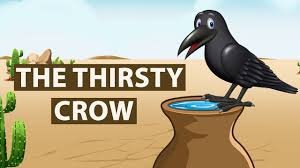The story of The Thirsty Crow’s Fable is one of the most enduring and universally recognized fables, with versions appearing in nearly every major culture around the world. While commonly attributed to Aesop, the tale actually predates the Greek storyteller by centuries, with early versions found in both the ancient Indian Panchatantra (circa 300 BCE) and Jataka tales of Buddhism. What makes this simple narrative so remarkable is how it perfectly encapsulates the human virtues of creativity, perseverance, and problem-solving in a way that transcends time and culture. The basic premise is familiar to most: a crow, dying of thirst, comes across a pitcher with water at the bottom, just out of reach of its beak. After failing to overturn the heavy vessel, the crow hits upon the ingenious solution of dropping pebbles into the pitcher one by one until the water level rises enough for it to drink. This elegant demonstration of tool use and causal understanding in animals was remarkably prescient – modern science has since confirmed that corvids (the crow family) do indeed possess exceptional problem-solving abilities comparable to primates.
The crow itself is a fascinating character when examined through the lens of cultural symbolism. In Western traditions, crows are often associated with ill omens, but in many Asian cultures, particularly Hindu and Buddhist traditions, they are revered as messengers and symbols of intelligence. This dichotomy reflects in the various versions of the tale – while Western retellings tend to focus purely on the crow’s cleverness as an individual trait, Eastern versions often emphasize the communal aspect, with the crow sometimes receiving advice from other animals or even divine beings. The pitcher too holds symbolic weight; in some Persian variations, it’s described as an ancient urn, representing the wisdom of ancestors, while in African oral traditions, it’s often a gourd, tying the story to daily village life. These cultural nuances reveal how the same core narrative was adapted to reflect different societal values while maintaining its universal appeal.
Scientific research has lent unexpected credibility to this ancient tale. Studies at the University of Cambridge and elsewhere have demonstrated that crows and their relatives can indeed solve complex problems, even creating tools to retrieve food. In one famous experiment, a New Caledonian crow bent a straight wire into a hook to lift a small bucket of food from a tube – an act of ingenuity strikingly similar to our fabled crow’s pebble solution. This real-world validation of the story’s central premise makes The Thirsty Crow unique among fables – what was once considered mere folk wisdom has been proven to reflect actual animal behavior. The story’s accuracy regarding crow intelligence is particularly remarkable considering it originated thousands of years before modern ethology.
The Thirsty Crow’s Fable’s educational applications are manifold. Cognitive psychologists use it to illustrate the concept of “insight learning” – the sudden realization of a solution to a problem. In children’s education, it serves as an early introduction to basic scientific principles like displacement and cause-and-effect. Business trainers have adapted it as a metaphor for innovative thinking in corporate environments, while engineers cite it when discussing iterative problem-solving approaches. The crow’s step-by-step methodology – assessing the problem, trying direct solutions, then devising an indirect approach – mirrors the scientific method itself, making this ancient story surprisingly relevant in STEM education today.
What most retellings omit are the darker variations found in some traditional versions. In certain African oral traditions, the story continues with the crow becoming arrogant about its intelligence and being tricked by other animals, serving as a caution against pride. Some Indian versions include a moral about sharing knowledge, as the crow teaches its technique to other thirsty birds. These variations add depth to what is often presented as a simple tale, reminding us that intelligence must be tempered with humility and community spirit. The story’s adaptability across cultures – from the deserts of the Middle East to the forests of Europe to the villages of Asia – speaks to its fundamental human truth: necessity truly is the mother of invention.
Modern interpretations have expanded The Thirsty Crow’s Fable’s relevance. Environmental educators use it to discuss water conservation and creative solutions to resource scarcity. The “crow and pitcher” has become a common motif in discussions about innovation under constraints, appearing in everything from startup culture to poverty alleviation strategies. Neuroscientists even reference it when explaining how the brain approaches problem-solving, with the crow’s pebble-dropping representing a perfect example of goal-directed behavior. As we face increasingly complex global challenges, this ancient story about a thirsty bird continues to offer profound insights about perseverance, adaptability, and thinking outside the proverbial pitcher.
Go to main page


